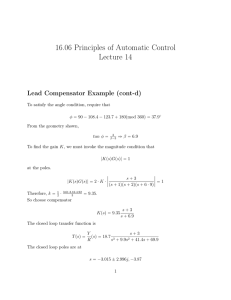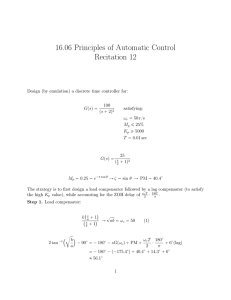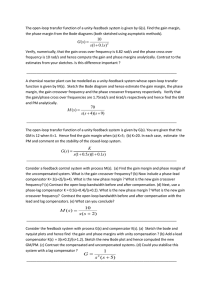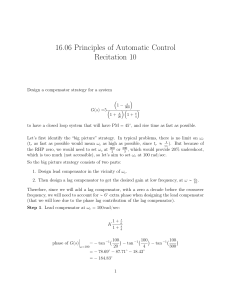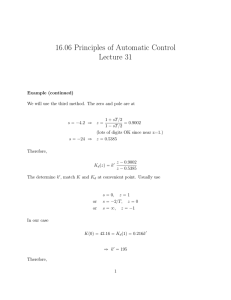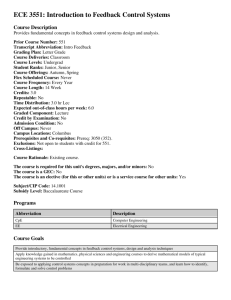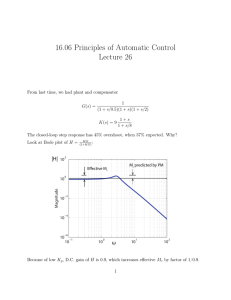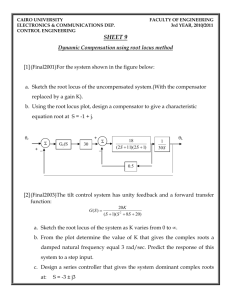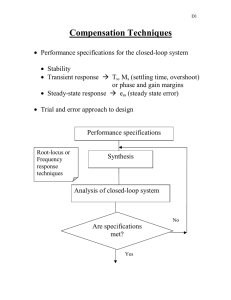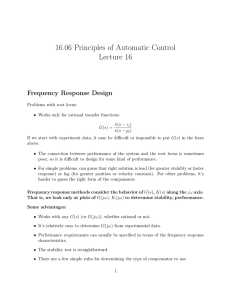Document 13352602
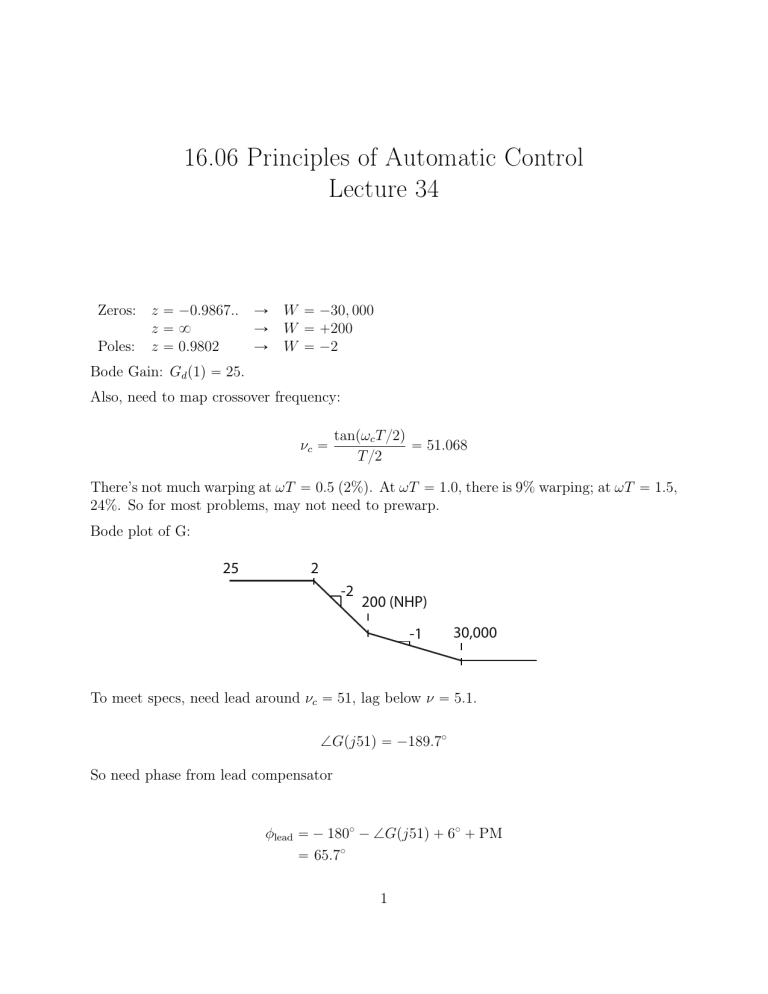
16.06
Principles of Automatic Control
Lecture 34
Zeros: z “ ´ 0 .
9867 ..
Ñ W “ ´ 30 , 000 z “ 8 Ñ W “ ` 200
Poles: z “ 0 .
9802 Ñ W “ ´ 2
Bode Gain: G d p 1 q “ 25 .
Also, need to map crossover frequency:
ν c
“ tan p ω c
T { 2 q
T { 2
“ 51 .
068
There’s not much warping at ωT “ 0 .
5 (2%). At ωT “ 1 .
0 , there is 9% warping; at ωT “ 1 .
5 ,
24%. So for most problems, may not need to prewarp.
Bode plot of G:
25 2
-2
200 (NHP)
-1 30,000
To meet specs, need lead around ν c
“ 51 , lag below ν “ 5 .
1 .
= G p j 51 q “ ´ 189 .
7 ˝
So need phase from lead compensator
φ lead
“ ´ 180 ˝
´ = G p j 51 q ` 6 ˝
` PM
“ 65 .
7 ˝
1
where 6 ˝ anticipates lag compensation.
ñ c b a
“ 4 .
65
ñ b “ 51 ¨ 4 .
65 “ 237 a “ 51 { 4 .
65 “ 11 .
0
1 ` W { 11
ñ K lead
“ 5 .
44
1 ` W { 237
For this compensator, K p
“ 136 .
So need lag ratio of 36.76.
W ` 5
ñ K lag
“
W ` 0 .
136
Therefore, the compensator is
W ` 5 1 ` W { 11
K p W q “ 5 .
44
W ` 0 .
136 1 ` W { 237
The discrete time compensator is the Tustin transform, yielding
K d p z q “ 57 .
97 p z ´ 0 .
9512 qp z ´ 0 .
8957 q p z ´ 0 .
9986 qp z ` 0 .
0847 q
Remarks:
1. Compensator is almost identical to what would be found if we used emulation, if we include effective T { 2 delay of ZOH.
2. W-Transform approach guarantees stability of discrete-time system. Not really an issue for ω c
T “ 0 .
5 , but might be for faster crossover.
3. Note RHP zero at wW “ `
2
T troller, just like time delay.
“ 200 .
This zero limits achievable bandwidth of con
Example
Same plant as above. Make ω c p ν c q as high as practical and still have 50 ˝ phase margin.
Solution: Let’s pick crossover frequency ν c to be factor of only 2 below NMP zero.
ν c
“ 100
2
Use lead compensator to get desired PM and crossover:
See step response below:
= G w p jω
0 q “ ´ 204 .
1 ˝
ñ
φ lead c b
“ ´ 180 a
“ 7 .
15
´ = G ` PM “ 74 .
1 ˝ b “ 100 ¨ 7 .
15 “ 715 a “ 100 { 7 .
15 “ 14
1 ` W { 14
ñ K
N p W q “ 12 .
53
1 ` W { 715
ñ K d p z q “ 149 .
7 z ´ 0 .
8692 z ` 0 .
5628
Direct Design
Suppose we have the usual unity feedback control structure:
3
r +
-
K G y
(The system might be continuous or discrete). Suppose we want the closed loop transfer function
KG
H “
1 ` KG to have a specific form, e.g., have a particular rise time, settling time, etc. Why not just solve for desired K in terms of G, H ?
H p 1 ` KG q “ KG
H “ ´ KGH ` KG
1 H
K “
G 1 ´ H
So
K “
1 H
G 1 ´ H
Note that K essentially cancels G with the factor 1 { G , so makes the loop gain
H
K “
1 ´ H exactly what is needed to have the desired closed loop transfer function.
But we can’t choose any H desired!
Constraints on H:
Stability In order that K not cancel on unstable pole or NMP zero, we must have that
1. H must have as zeros all the zeros of G outside the unit circle.
2. 1 ´ H must have as zeros all the unstable poles of G .
Causality In order that K be causal, we must have:
3. The relative degree of H is at least as large as the relative degree of G .
4
Example
25
G p s q “ p 1 ` s { 2 q
2 z ` 0 .
9867
G d p z q “ 0 .
004934 p z ´ 0 .
9802 q
2
T “ 0 .
01 do a direct design such that
1. The system is Type 1: ñ H p 1 q “ 1 .
2. The system is deadbeat (all poles of H at z “ 0 ).
Therefore, might select
H p z q “
1 z ` 1
2 z 2
Then
K d p z q “
G d
1 1
¨ ¨ p z q 2 z z ` 1
2
´ 0 .
5 z ´ 0 .
5
See responses on next two pages. Note the “ringing” in u r k s .
To eliminate, put zero of H at
´ 0 .
9867 .
5
To eliminate ringing, choose
1
H p z q “
1 .
9867 z ` 0 .
9867 z 2
6
7
MIT OpenCourseWare http://ocw.mit.edu
16.06
Principles of Automatic Control
Fall 20 1 2
For information about citing these materials or our Terms of Use, visit: http://ocw.mit.edu/terms .
